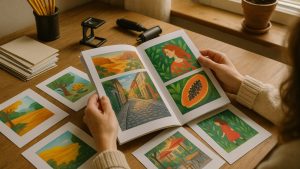
⏱️ Estimated reading time: 4 minutes
So, you’ve poured your heart into writing your book — but when it comes to printing, all those industry terms can be a bit overwhelming, right? Whether you’re self-publishing or working with a printer, knowing the basics like ‘GSM,’ ‘perfect binding,’ or ‘digital vs litho’ can make a huge difference in getting exactly what you want. I’ve spent years helping authors and publishers through this maze, and I should mention — understanding these terms doesn’t just help you avoid surprises; it also means you can make smarter decisions that save time and money.
What Does GSM Mean and Why Does It Matter?
GSM stands for grams per square metre, and it’s basically the weight of the paper. You’ve probably noticed that some books feel heavier or more luxurious — that’s usually because of a higher GSM. For instance, typical text pages might be around 80-100 GSM, but covers often use thicker stock, like 250-350 GSM, to give a sturdy feel. Choosing the right GSM affects not just the look and feel but also the durability and even how the ink sits on the page.
Understanding Binding Types: Perfect, Wiro, and Stapled
Binding can be a maze, but here are the main ones you’ll encounter:
- Perfect Binding: This is when the pages are glued together at the spine and a cover wraps around — think of your typical paperback. It’s great for books with lots of pages, giving a clean, professional finish.
- Wiro Binding: Also called wire or spiral binding, it uses a metal coil. Perfect for booklets or manuals that need to lie flat.
- Stapled (Saddle Stitch): This involves folding sheets and stapling them along the fold. It’s ideal for thinner booklets or pamphlets, usually up to about 64 pages.
Knowing these helps you pick the best style for your book’s purpose and page count.
Litho vs Digital Printing: What’s the Difference?
You might hear these terms thrown around a lot. Litho (short for lithography) is a traditional printing method that’s cost-effective for large print runs — say, 1,000 copies or more. It typically offers richer colours and is great for consistent quality across thousands of pages.
Digital printing, on the other hand, is perfect for short runs or print-on-demand projects. It’s faster, requires less setup, and lets you print as few as one copy, which is a real boon if you’re testing the waters or want to avoid large upfront costs.
We’ve seen local authors do short-run digital prints first, then move to litho as their demand grows. It’s a flexible approach that keeps waste and risk down.
Trim Size and Bleed: Why They’re Crucial
Trim size is the final size of your printed book after all the cutting. It’s worth choosing standard sizes like A5 or A4, as they’re easier to produce and often more cost-effective. But if you want something unique, custom sizes are available too — just remember, special sizes might bump up your price or lead times.
Bleed refers to the extra image or colour that extends beyond the trim edge. It’s essential for designs that go right to the edge, preventing those annoying white borders caused by slight cutting variations.
Quick Tips for Authors Ordering Their First Print Run
- Ask your printer about paper options and request samples if possible — feeling the paper can change your mind!
- Clarify page counts and binding types early on; it affects cost and production time.
- Consider whether a matte or gloss finish suits your book’s tone better — matte feels soft and understated, gloss adds shine and vibrancy.
- Check if your printer offers eco-friendly or recycled paper options, especially if sustainability is important to you.
- Don’t forget to account for the spine width if you’re doing perfect binding — it depends on page count and paper thickness.
A Quick Example from Real Life
We recently worked with a first-time author who was unsure about how many copies to print. After explaining the differences between digital and litho, we recommended a short digital run of 200 copies using 100 GSM paper with perfect binding and a matte laminated cover. This kept costs manageable and gave her high-quality books to sell at local events. When demand rose, she came back for a larger litho print run that slashed the per-unit cost. It’s a great example of adapting printing choices as your project grows.
Anyway, the point is — printing your book is as much about understanding the process as it is about the content. Taking the time to learn these common terms means you’ll feel confident and in control, and ultimately, you’ll end up with a book that looks and feels just right.
Written by Taylor Reed
Print Expert at newstyleprint.co.uk. They share practical insights from hands-on print work across litho, digital and wide-format projects.
Updated on 11 November 2025
Ready to print? Contact Newstyle Print for a fast quote today.
Call 01572 771377 or email hello@newstyleprint.co.uk
Get a quote »





